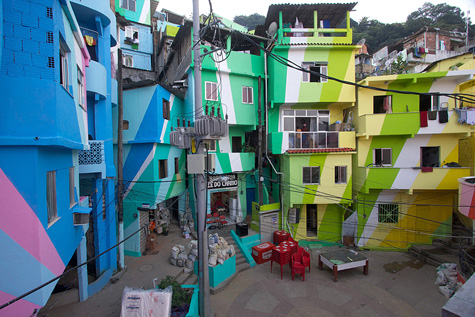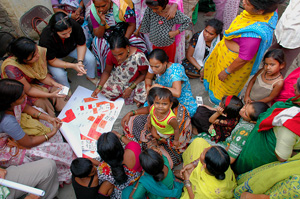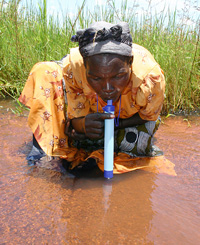
Solar lanterns. Bicycle-powered cell phone chargers. A personal water-purifier the size of a large straw.
Today, some of the world’s most creative, challenging and sophisticated design is found not in museums or showrooms, but in the poor, makeshift urban settlements — the favelas, shanty towns and other informal communities — that collectively house nearly a billion people.
In September, the Mildred Lane Kemper Art Museum at Washington University in St. Louis will present Design with the Other 90%: CITIES, a major survey that aims to expand contemporary definitions of just what constitutes “good design.” Collecting dozens of smart, problem-solving projects from around the globe, the exhibition illustrates the profound, transformative and sometimes lifesaving power of innovative design.

The Other 90%
“Professional designers have traditionally focused on the 10 percent of the world’s population that can afford their goods and services,” says Cynthia E. Smith, curator of socially responsible design for the Smithsonian’s Cooper-Hewitt, National Design Museum, who organized the exhibition.
Design with the Other 90%: CITIES, which debuted last year at the United Nations, builds on Smith’s 2007 survey, titled Design for the Other 90%. The Kemper Art Museum exhibit assimilates elements of both shows.
“A new wave of designers, architects, engineers, non-governmental organizations (NGOs) and philanthropists is working directly with people with limited resources, collaborating across sectors to find solutions and using emerging technology that ‘leapfrogs’ poorer communities into the 21st century,” Smith says.
“They are proving that design can play a significant role in solving the world’s most critical problems.”
“How do we judge good design?”
Design with the Other 90%: CITIES highlights groundbreaking ventures across a variety of scales, from individual products to comprehensive strategies for urban farming, housing, health, education, sanitation and recycling.
“For much of the world, these are crucial, everyday concerns,” says Peter MacKeith, adjunct associate curator of architecture and design at the Kemper Art Museum as well as associate dean and associate professor of architecture in WUSTL’s Sam Fox School of Design & Visual Arts. “Where to get clean water? How to construct housing? Where to charge a cell phone?”
All of which suggests another question: “How do we judge good design?” MacKeith asks. “In aesthetic terms? In ethical terms? Do we judge goodness of construction or goodness of heart?
“Ideally, it is all of those things,” he says.

Perhaps emblematic of the installation is LifeStraw®, a 10-inch water-purifier that has proven effective against typhoid, cholera, dysentery and other waterborne diseases. The exhibition will feature 1,000 of the light blue tubes, suspended from the ceiling like sheets of rain. Visitors will be able to sponsor the gift of a LifeStraw® through a designated charity.
Other examples range from Uganda’s Digital Drum — a rugged, solar-powered computer kiosk housed in a steel oil drum — to Kenya’s M-PESA system, which allows urban workers to safely send money home to rural families using their mobile devices. The open-source Map Kibera helps communities formally chart informal settlements — a critical first step in securing much-needed services.
The exhibition is designed by architects (and frequent museum collaborators) Frank Escher and Ravi Gunewardena of Los Angeles. Their work — funded in part by a WUSTL I-CARES grant — intends to make the understanding of sustainable design physical, tactile and visceral.
“What holds these projects together is an immense empathy and compassion,” MacKeith says. “Sometimes that empathy emerges from designers, working with communities, manufacturers or NGOs. Sometimes it emerges from the community itself, working on its own behalf. All seek to make the world a little better.”
A semester’s conversation
Design with the Other 90%: CITIES coincides with a series of events celebrating the 50th anniversary of the Sam Fox School’s Master of Urban Design (MUD) program. Founded by Fumihiko Maki and Roger Montgomery, the program was among the first in the nation, with alumni at major planning, architecture, landscape architecture and urban design practices around the world.
In conjunction with both the exhibition and the anniversary, the Kemper Art Museum, the Sam Fox School and other campus areas will host a series of events investigating the current state of cities as well as efforts to develop healthy and sustainable urban environments.
Highlights will include a lecture by Cynthia Smith (Sept. 14); a symposium on sustainable cities (Nov. 9-11); and a Sustainable Cities Week, hosted by WUSTL’s Office of Sustainability. Associate Professor John Hoal, who directs the MUD program, also will curate a related exhibition, Ways of Seeing the City, in the museum’s Teaching Gallery.
In addition, MacKeith and Rob Puentes, director of the Brookings Institution’s Metropolitan Infrastructure Initiative, will convene a symposium on “The Innovative Metropolis: Fostering Economic Competitiveness Through Sustainable Urban Design.” The symposium will take place at the Brookings Institution in Washington, D.C., Feb. 21, 2013.
Hours and reception
Design with the Other 90%: CITIES will open with a public reception from 6 to 8 p.m. Friday, Sept. 14, and will remain on view through Jan. 7, 2013.
In addition, curator Smith will discuss the exhibition — and the collaborative design exchange occurring between designers, architects, engineers and philanthropists who are working directly with urban settlers with limited resources — at 5 p.m. in Steinberg Auditorium. Both the lecture and the exhibition are free and open to the public.
The Kemper Art Museum and Steinberg Auditorium are located on Washington University’s Danforth Campus, immediately adjacent to one another, near the intersection of Skinker and Forsyth boulevards. Regular museum hours are 11 a.m. to 6 p.m. Mondays, Wednesdays and Thursdays; 11 a.m. to 8 p.m. Fridays; and 11 a.m. to 6 p.m. Saturdays and Sundays. The museum is closed Tuesdays.
For more information, call (314) 935-4523 or visit kemperartmuseum.wustl.edu.
Sponsors
Design with the Other 90%: CITIES was organized by the Smithsonian’s Cooper-Hewitt, National Design Museum. This exhibition’s presentation at the United Nations was sponsored by Citi. Generous support was provided by the Rockefeller Foundation. Additional funding was provided by Procter & Gamble, Deutsche Bank, Smithsonian 2.0 Fund, the Albert Kunstadter Family Foundation, and Smithsonian Institution’s Research Opportunity Fund.
Support for the exhibition at the Mildred Lane Kemper Art Museum is generously provided by I-CARES at Washington University in St. Louis; the Charles and Bunny Burson Art Fund at the Sam Fox School of Design & Visual Arts; the Missouri Arts Council, a state agency; James M. Kemper Jr.; the David Woods Kemper Memorial Foundation; John and Anabeth Weil; the Hortense Lewin Art Fund; and members of the Mildred Lane Kemper Art Museum.
Further generous support is provided by additional units of Washington University: the Office of the Provost, the Office of the Executive Vice Chancellor for Administration, the Institute for Public Health, the Center for Social Development and the Skandalaris Center for Entrepreneurial Studies.
The Make a House Intelligent project in St. Louis was made possible by Tarlton Corp. with additional support from Ben Hur Construction Co., John J. Smith Masonry, Kirberg Roofing Company and Rock Hill Mechanical Corp.